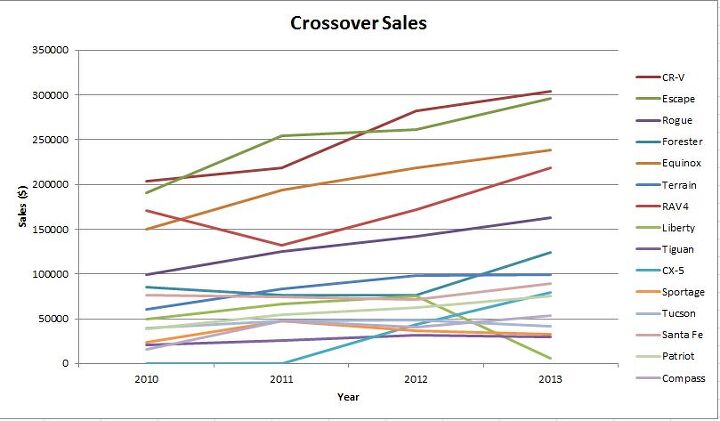Chart Of The Day: Here's What The Jeep Cherokee Is Up Against In 2014
With the first month of 2014 sales nearly wrapped up, we’ll soon get our first look at how the Jeep Cherokee has fared, following the initial shipment of delayed units. Much has been made of the Cherokee selling 10,000 units in November and 15,000 units in December: it was a great storyline for Chrysler to promote in the run-up to NAIAS, and one for the hometown media (in both Detroit and Toledo) to rally around. Left out of the cheerleading was the fact that these figures accounted for the 25,000 units reportedly sent to dealers in one fell swoop. Can you say “pent up demand”?
But even if the Cherokee continued to sell at that pace – say, 15,000 units per month as an optimistic projection, where would that place it in the larger picture of the small crossover segment?
Small crossovers may not be popular with enthusiasts, but it’s impossible to deny how important this is to the industry at large. In 2013, five of the top 10 best selling SUVs in America were small crossovers, while the Honda CR-V and Ford Escape (the top selling small crossovers) were the 8th and 10th best selling vehicles in America. Together, those two made up just under 1/3rd of the segment’s volume. Add in the third place Chevolet Equinox and fourth place Toyota RAV4 and you have 57 percent of the segment represented in just four nameplates.
The graph above represents the uneven distribution of the segment’s sales, with the top four nameplates sitting comfortable, while a number of small players compete for scraps at the bottom of the graph. This isn’t unique in the market either – Juan Barnett’s analysis of the midsize market shows a somewhat similar distribution of nameplates clustered at the top and bottom. Like the midsize segment, the small crossover category is a crowded one, and the addition of the Cherokee just adds to the competition.
Assuming the 15,000 unit pace holds through 2014, that would give the Cherokee 180,000 units at year end, placing it above the Nissan Rogue (which sells roughly 160,000 units) but below the RAV4. In that context, the 15,000 unit per month figure being bandied about is far less impressive, but it’s important to note a couple things.
The Toldeo, Ohio factory that builds the Cherokee is capacity limited to about 250,000 Cherokees per year. Even running flat out, Jeep wouldn’t be able to catch the CR-V or Escape. Considering that some of the 250,000 units will go to Canada and other global markets, 180,000 is a respectable number. Even more significant is what the Cherokee will do for the Jeep brand compared to the Liberty (as demonstrated in the chart below).
The comparison with the Rogue will be an interesting one. In the same way that the 200 should sell at the level of the Optima, Malibu or Sonata, the Cherokee and Rogue will likely inhabit the same stratosphere in the segment. The new Rogue has also undergone Nissan’s patented process of making cars suitably bland for American tastes, through their expanded dealer network. Similar to the Altima’s gradual climb through the midsize ranks, the combined capacity for 180,000 units of the Rogue (100,000 in Smyrna, Tennessee and 80,000 at the Renault-Nissan facility in Korea), combined with additional units of the Rogue Select (which Nissan will likely not break out from Rogue sales) should enable to Rogue to post higher sales figures by the end of 2014. On the other hand, don’t expect things to change at the top.
More by Derek Kreindler
Latest Car Reviews
Read moreLatest Product Reviews
Read moreRecent Comments
- IBx1 Everyone in the working class (if you’re not in the obscenely wealthy capital class and you perform work for money you’re working class) should unionize.
- Jrhurren Legend
- Ltcmgm78 Imagine the feeling of fulfillment he must have when he looks upon all the improvements to the Corvette over time!
- ToolGuy "The car is the eye in my head and I have never spared money on it, no less, it is not new and is over 30 years old."• Translation please?(Theories: written by AI; written by an engineer lol)
- Ltcmgm78 It depends on whether or not the union is a help or a hindrance to the manufacturer and workers. A union isn't needed if the manufacturer takes care of its workers.




































Comments
Join the conversation
For as maligned a vehicle as the Cherokee was, I see a ton of them on the road already. I personally don't think they look that bad at all, especially in the darker colors.
Saw it at the Houston car show last night, it's pretty nice and about the right size for me and I'm not a lover of SUVs. In all black the front end details are kind of lost. People were checking it out so it might sell well.